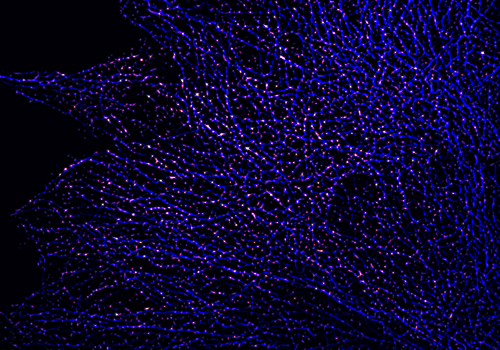Powering cell transport by chance

New insights into long-haul transport of molecular cargo in mammalian cell lines revealed with super-resolution microscopy.
Using live cell, single-molecule imaging in mammalian cells, UNSW Sydney medical researchers were able to watch the motor protein – dynein – in action as it moved molecular cargo along intracellular tracks. The exquisite molecular detail provided new insight into what drives dynein-mediated transport in mammalian cells and the dynamics of how this happens.
Dynein hauls vital cargo – including molecular building blocks, signalling molecules and mRNA – to maintain cellular functions. Virtually all cargo moving from the outer edges of the cell toward the centre are ferried by cytoplasmic dynein-1. These multi-tasking molecular motors also organise and re-position organelles within cells, and are sometimes hijacked by viruses to help them reach the nucleus. But figuring out exactly how dynein works has been fraught.
Based on their observations, the team published their model of how dynein is set in motion in the Journal of Cell Biology, and detailed their approach to uncovering this mechanism.
“It's a combination of using the right technique as well as the right cells that enabled us to look at the single molecules of dyneins in cell lines for the first time,” said study lead and EMBL Australia Group Leader, Dr Vaishnavi Ananthanarayanan.
Previously studies have relied on recreating the transport system using purified proteins, but the functional dynamics have not been examined within the complex environment of cells. Their experimental set up allowed them to monitor the behaviour of the three components previously found to be crucial for dynein to be an active motor: dynein; dynactin, a regulator of dynein; and a cargo adaptor that links dynein to the cargo.
Dr Ananthanarayanan explains that the network of tracks, or microtubules, in cells serve as a hub for the molecular trio to come together at the same time to form an active complex. Her team discovered that dynein and dynactin bound to the microtubules with different dynamics. While dynein interacted transiently, dynactin, together with the cargo adaptor, remained more persistently bound to microtubules.
Their findings show that random and serendipitous encounters of dynein with the other two components of the complex are what trigger cargo movement toward the nucleus.
“Dynein samples the microtubules frequently, and when it does encounter this dynactin-cargo adapter complex it is capable of moving in a short, directed run,” Dr Ananthanarayanan said.
In the model they proposed, dynein detaches from the microtubules and continues searching when there is no dynactin and cargo.
While the prevailing hypothesis in the field is that clusters of motors were required to drive long-rage transport, the observations from Dr Ananthanarayanan’s team suggest that this may not be necessary.
“Short stochastic interactions are sufficient to bring about long-range movements. You don’t necessarily need groups of motors sitting on cargo to drive movement,” she said.
This new insight could help researchers find ways to alter the movement of cargo transport to improve cell functions when problems arise, such as in cancers or neurological conditions.
“These findings give us a handle to manipulate cargo movement in cells,” Dr Ananthanarayanan said.
[Image: Dynein must bind to dynactin (magenta) and cargo before it can actively move toward the cell's centre, along microtubules (blue)]


